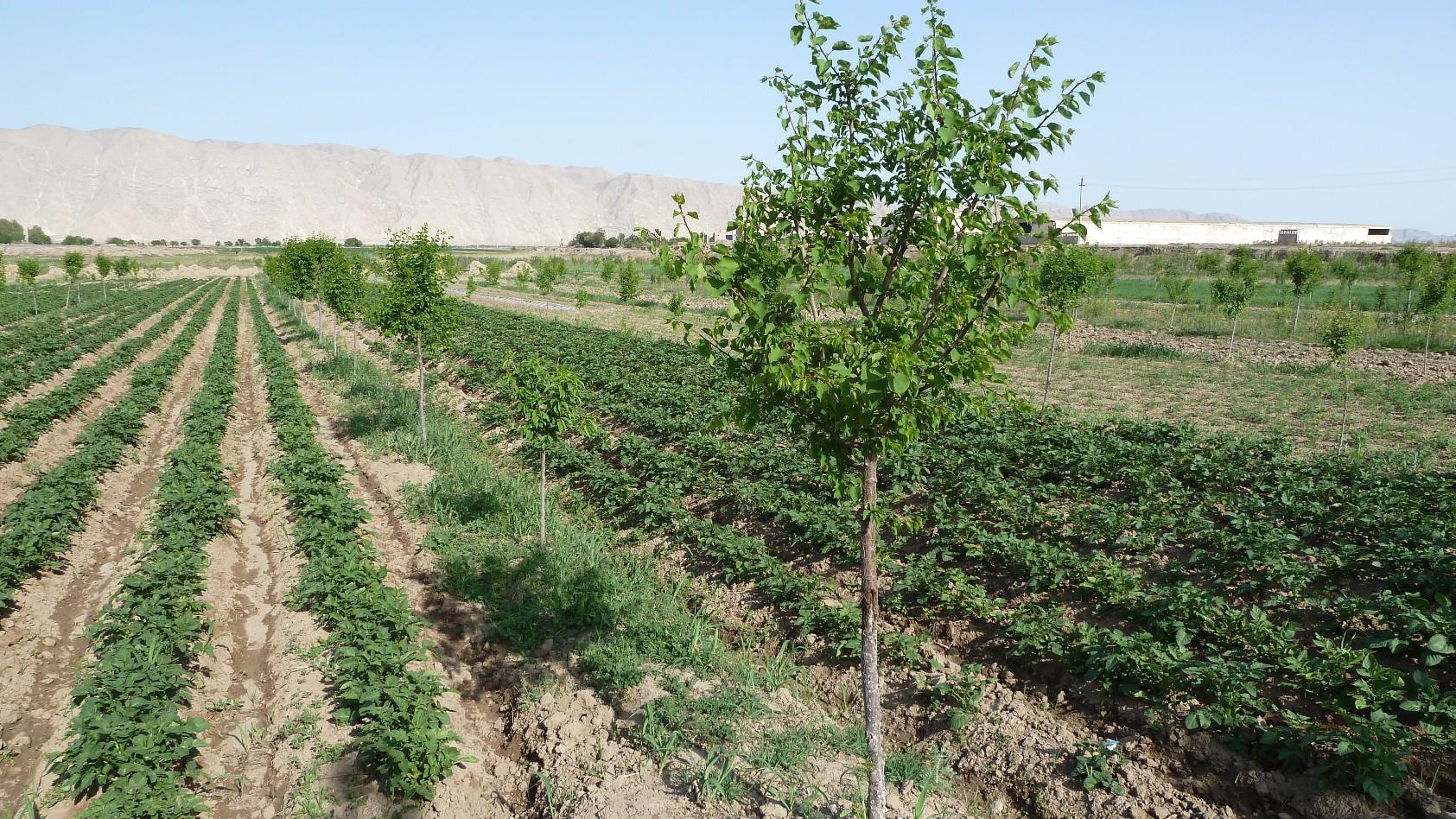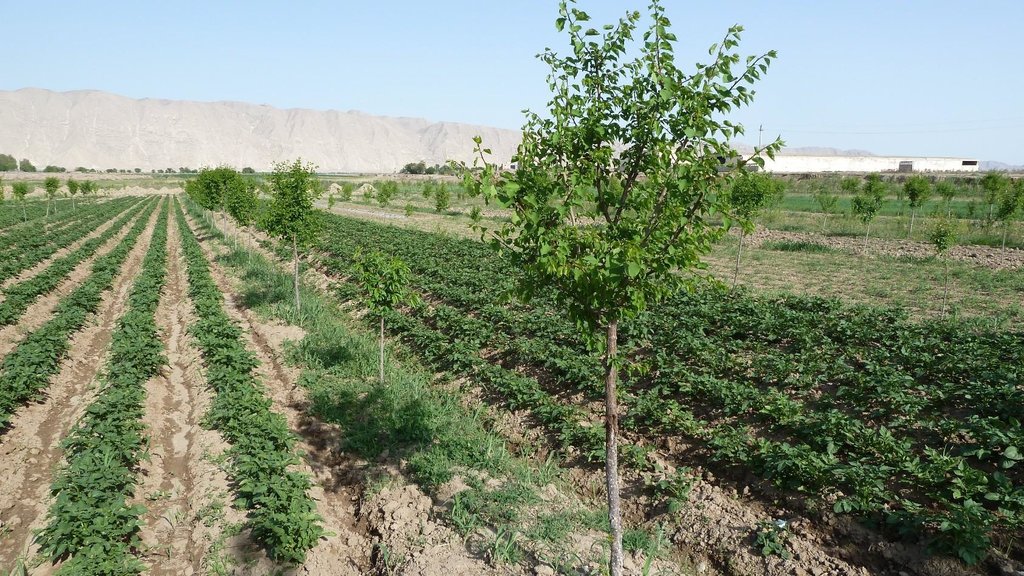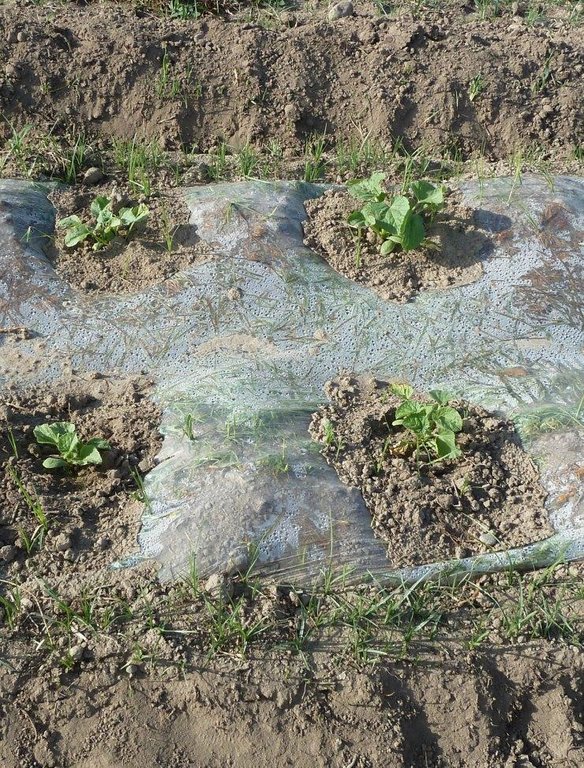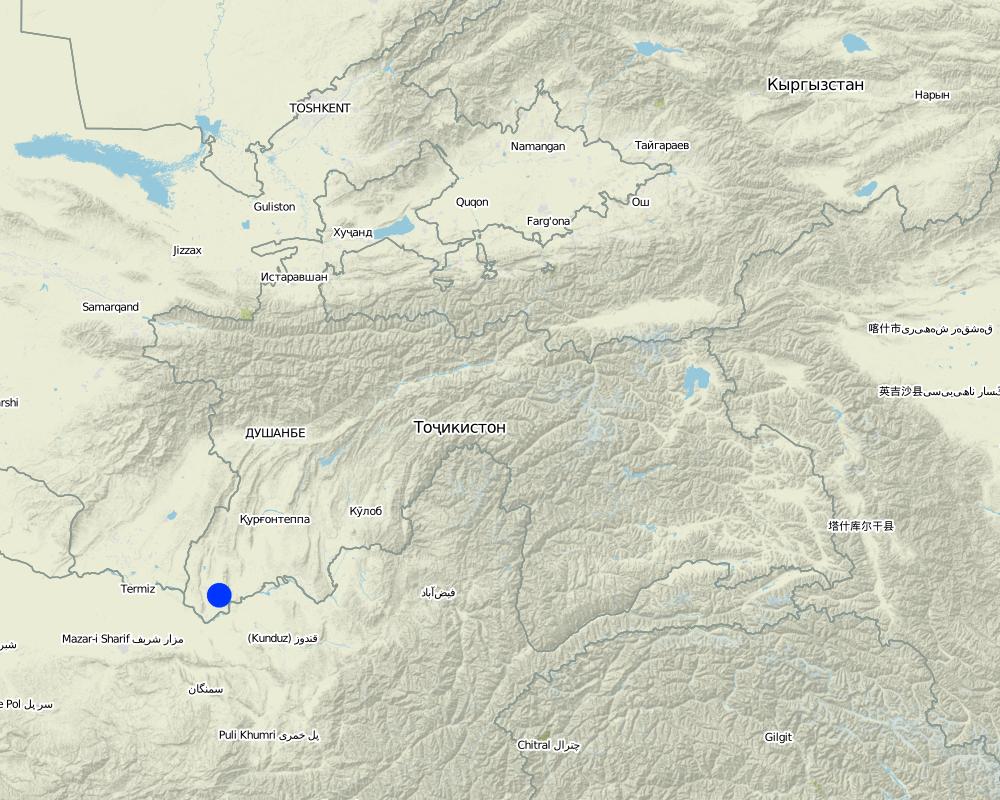Rehabilitation of poor soils through agroforestry [ทาจิกิสถาน]
- ผู้สร้างสรรค์:
- การอัพเดท:
- ผู้รวบรวม: Natalia Mityakova
- ผู้เรียบเรียง: –
- ผู้ตรวจสอบ: David Streiff, Alexandra Gavilano
Tajikistan - Central Asian Countries Initiative for Land Management (CACILM/ИСЦАУЗР)
technologies_1052 - ทาจิกิสถาน
- บทสรุปทั้งหมดในรูปแบบของ PDF
- บทสรุปทั้งหมดในรูปแบบของ PDF เพื่อพิมพ์
- บทสรุปทั้งหมดในรูปหน้าเว็บ
- บทสรุปทั้งหมด (ไม่มีการจัดเรียง)
- Rehabilitation of poor soils through agroforestry: 15 มีนาคม 2017 (inactive)
- Rehabilitation of poor soils through agroforestry: 20 กรกฎาคม 2017 (inactive)
- Rehabilitation of poor soils through agroforestry: 21 สิงหาคม 2019 (inactive)
- Rehabilitation of poor soils through agroforestry: 2 พฤศจิกายน 2021 (public)
ดูส่วนย่อย
ขยายทั้งหมด ย่อทั้งหมด1. ข้อมูลทั่วไป
1.2 รายละเอียดที่ติดต่อได้ของผู้รวบรวมและองค์กรที่เกี่ยวข้องในการประเมินและการจัดเตรียมทำเอกสารของเทคโนโลยี
ผู้เชี่ยวชาญ SLM:
ผู้เชี่ยวชาญ SLM:
ผู้เชี่ยวชาญ SLM:
Urakov Buran
buran.urakov@undp.org
UNDP
ทาจิกิสถาน
ชื่อขององค์กรซึ่งอำนวยความสะดวกในการทำเอกสารหรือการประเมินเทคโนโลยี (ถ้าเกี่ยวข้อง)
United Nations Development Program (United Nations Development Program) - ทาจิกิสถานชื่อขององค์กรซึ่งอำนวยความสะดวกในการทำเอกสารหรือการประเมินเทคโนโลยี (ถ้าเกี่ยวข้อง)
CDE Centre for Development and Environment (CDE Centre for Development and Environment) - สวิตเซอร์แลนด์ชื่อขององค์กรซึ่งอำนวยความสะดวกในการทำเอกสารหรือการประเมินเทคโนโลยี (ถ้าเกี่ยวข้อง)
Central Asian Countries Initiative for Sustainable Land Management - Multicountry Capacity Building (CACILM - MCB) - คีร์กีซสถาน1.3 เงื่อนไขการใช้ข้อมูลที่ได้บันทึกผ่านทาง WOCAT
วันที่เก็บรวบรวมข้อมูล(ภาคสนาม) :
13/04/2011
ผู้รวบรวมและวิทยากรหลักยอมรับเงื่อนไขเกี่ยวกับการใช้ข้อมูลที่ถูกบันทึกผ่านทาง WOCAT:
ใช่
2. การอธิบายลักษณะของเทคโนโลยี SLM
2.1 การอธิบายแบบสั้น ๆ ของเทคโนโลยี
คำจำกัดความของเทคโนโลยี:
An agroforestry system with peach, plum, sweet cherry and persimmon trees was established on a plot of land, with poor soil quality.
2.2 การอธิบายแบบละเอียดของเทคโนโลยี
คำอธิบาย:
In the arid environment of Kabodion, large areas that had been irrigated during the Soviet times were abandoned after independence, and the irrigation facilities were neglected. Soils were highly degraded due to the long periods they had been without proper irrigation. On an area of poor quality soil, and previously abandoned plot of land covering about 6 ha, UNDP supported one family (Dehkan)to establish an agroforestry system by covering the costs of tree seedlings.
Purpose of the Technology: The aim of the technology was to improve agricultural production through a combination of measures such as improving soil fertility, increasing soil humidity through covering the soil with plastic sheets and preventing excess water drainage, and protection through a shelterbelt. Resilience to adverse climatic events is enhanced by increasing product diversification with a number of different tree, vegetable and crop species being planted.
Establishment / maintenance activities and inputs: First, the soil had to be washed to reduce the high salt content. Plum, peach, sweet cherry and persimmon tree seedlings were planted in lines with intercropping of potatoes, watermelon, beans and wheat inbetween. The seedlings were purchased from the Kabodion nursery. Labour was provided in the form of "hashar" or voluntary neighbourhood help. On the windward side of the field, a shelterbelt consisting of White Poplar (Populus alba) trees was established to protect the field from wind erosion, and to reduce evapotranspiration. In order to improve soil structure annual crop rotations were practiced. Every 4 years 40 tones of cow dung are spread out per ha of land. The application of organic manure constitutes an important cost factor for the farmer, as 40 tons of manure costs about 180 to 220 USD. To improve soil humidity and to enable early planting for watermelons, cultivation seeds are planted under a tight plastic film with irrigation water filled underneath the sheet. As soon as the seedlings emerge a hole is made in the plastic to create space for the plants. Irrigation is applied only sparingly to prevent the soil from a new rise in salinity. The plot is situated on a gentle slope which facilitated the establishment of a drainage system by digging a trench at the foot of the field to absorb excess water. The farmer was able to cover the costs of this initial investment himself using the revenues from the first harvest. At the foot of this field, salt tolerant Russian Silverberry (Elaeagnus angustifolia) trees were planted to promote biodrainage to help prepare the adjacent land for conversion to agroforestry at a later stage. The farmer gained the knowledge that was necessary for the establishment of the system through attending the farmer field schools (see approach TAJ018).
Natural / human environment: This technology is suitable for other arid environments, and the economic benefits are high compared to the establishment and maintenance costs. When this was realised by the neighbouring farmers they adopted the technology on an area of land that was actually three times larger.
2.3 รูปภาพของเทคโนโลยี
2.5 ประเทศภูมิภาค หรือสถานที่ตั้งที่เทคโนโลยีได้นำไปใช้และได้รับการครอบคลุมโดยการประเมินนี้
ประเทศ:
ทาจิกิสถาน
ภูมิภาค/รัฐ/จังหวัด:
Khatlon, Kabodion
ข้อมูลจำเพาะเพิ่มเติมของสถานที่ตั้ง :
Khudokulov Jamoat
Map
×2.6 วันที่การดำเนินการ
ถ้าไม่รู้ปีที่แน่นอน ให้ระบุวันที่โดยประมาณ:
- น้อยกว่า 10 ปี (ไม่นานนี้)
2.7 คำแนะนำของเทคโนโลยี
ให้ระบุว่าเทคโนโลยีถูกแนะนำเข้ามาอย่างไร:
- ทางโครงการหรือจากภายนอก
3. การจัดประเภทของเทคโนโลยี SLM
3.1 วัตถุประสงค์หลักของเทคโนโลยี
- ลด ป้องกัน ฟื้นฟู การเสื่อมโทรมของที่ดิน
3.2 ประเภทของการใช้ที่ดินในปัจจุบันที่ได้นำเทคโนโลยีไปใช้

พื้นที่ปลูกพืช
- การปลูกพืชล้มลุกอายุปีเดียว
- การปลูกไม้ยืนต้น ไม้พุ่ม
พืชหลัก (พืชเศรษฐกิจและพืชอาหาร):
major food crop: potatoes, wheat, beans, watermelons

การใช้ที่ดินแบบผสมผสาน (รวมถึงวนเกษตร)
- วนเกษตร (Agroforestry)
ผลิตภัณฑ์หลักหรือบริการ:
major food crop: plum, peach, sweet cherries, persimmons
แสดงความคิดเห็น:
Major land use problems (compiler’s opinion): degradation of vegetation cover, loss of topsoil through wind erosion, poor access to irrigation water,
Major land use problems (land users’ perception): salinity, waterlogging, low soil fertility, low agricultural production
Future (final) land use (after implementation of SLM Technology): Mixed: Mf: Agroforestry
ถ้าการใช้ที่ดินมีการเปลี่ยนแปลงเนื่องมาจากการนำเทคโนโลยีไปปฏิบัติใช้ ให้ระบุการใช้ที่ดินก่อนนำเทคโนโลยีไปปฏิบัติใช้:
Other: Oo: Other: wastelands, deserts, glaciers, swamps, recreation areas, etc
3.3 ข้อมูลเพิ่มเติมเกี่ยวกับการใช้ที่ดิน
การใช้น้ำของที่ดินที่มีการใช้เทคโนโลยีอยู่:
- การชลประทานแบบเต็มรูปแบบ
จำนวนของฤดูเพาะปลูกต่อปี:
- 2
ระบุ:
Longest growing period in days: 240Longest growing period from month to month: October - May (winter wheat)Second longest growing period in days: 120Second longest growing period from month to month: June-September
3.4 กลุ่ม SLM ที่ตรงกับเทคโนโลยีนี้
- การปลูกป่าร่วมกับพืช
- การปรับปรุงดิน / พืชคลุมดิน
- การปรับปรุงพันธุ์พืชหรือพันธุ์สัตว์ต่าง ๆ
3.5 กระจายตัวของเทคโนโลยี
ระบุการกระจายตัวของเทคโนโลยี:
- ใช้ ณ จุดที่เฉพาะเจาะจงหรือเน้นไปยังบริเวณพื้นที่ขนาดเล็ก
แสดงความคิดเห็น:
Total area covered by the SLM Technology is 0.06 m2.
The technology was initially applied on 5.8 ha of denuded land, however, it has been spontaneously adopted by a neighbour who has about 18 ha.
3.6 มาตรการ SLM ที่ประกอบกันเป็นเทคโนโลยี

มาตรการจัดการพืช
- A1: พืช/สิ่งปกคลุมดิน
- A2: อินทรียวัตถุในดิน/ความอุดมสมบูรณ์ในดิน
- A3: การรักษาหน้าดิน

มาตรการอนุรักษ์ด้วยวิธีพืช
- V1: ต้นไม้และพุ่มไม้คลุมดิน

มาตรการอนุรักษ์ด้วยโครงสร้าง
- S3: Graded ditches, channels, waterways
แสดงความคิดเห็น:
Main measures: agronomic measures, vegetative measures
Secondary measures: structural measures
Type of agronomic measures: manure / compost / residues, rotations / fallows, furrows (drainage, irrigation)
Type of vegetative measures: aligned: -along boundary, aligned: -linear
3.7 รูปแบบหลักของการเสื่อมโทรมของที่ดินที่ได้รับการแก้ไขโดยเทคโนโลยี

การกัดกร่อนของดินโดยลม
- Et (Loss of topsoil): การสูญเสียดินชั้นบน

การเสื่อมโทรมของดินทางด้านเคมี
- Cn (Fertility decline): ความอุดมสมบูรณ์และปริมาณอินทรียวัตถุในดินถูกทำให้ลดลงไป (ไม่ได้เกิดจากสาเหตุการกัดกร่อน)
- Cs (Salinization/alkalinization): การสะสมเกลือหรือการทำให้เป็นด่าง

การเสื่อมโทรมของดินทางด้านกายภาพ
- Pw (Waterlogging): ภาวะชุ่มน้ำ

การเสื่อมโทรมของดินทางด้านชีวภาพ
- Bc (Reduction of vegetation cover): การลดลงของจำนวนพืชที่ปกคลุมดิน
- Bs (Quality and species composition): องค์ประกอบหรือความหลากหลายทางคุณภาพและชนิดพันธุ์ลดลง

การเสื่อมโทรมของน้ำ
- Ha (Aridification): การเกิดความแห้งแล้ง
แสดงความคิดเห็น:
Main type of degradation addressed: Cn: fertility decline and reduced organic matter content, Cs: salinisation / alkalinisation, Pw: waterlogging, Ha: aridification
Secondary types of degradation addressed: Et: loss of topsoil, Bc: reduction of vegetation cover, Bs: quality and species composition /diversity decline
Main causes of degradation: soil management (soils were under irrigation for a long time and had salinity problems), droughts, inputs and infrastructure: (roads, markets, distribution of water points, other, …) (breakdown of irrigation facilities), education, access to knowledge and support services (lack of knowledge about agroforestry), governance / institutional (no freedom to farm)
3.8 การป้องกัน การลดลง หรือการฟื้นฟูความเสื่อมโทรมของที่ดิน
ระบุเป้าหมายของเทคโนโลยีกับความเสื่อมโทรมของที่ดิน:
- ฟื้นฟูบำบัดที่ดินที่เสื่อมโทรมลงอย่างมาก
แสดงความคิดเห็น:
Main goals: rehabilitation / reclamation of denuded land
4. ข้อมูลจำเพาะด้านเทคนิค กิจกรรมการนำไปปฏิบัติใช้ ปัจจัยนำเข้า และค่าใช้จ่าย
4.2 ข้อมูลจำเพาะด้านเทคนิคและการอธิบายแบบแปลนทางเทคนิค
Technical knowledge required for field staff / advisors: moderate
Technical knowledge required for land users: moderate
Main technical functions: control of concentrated runoff: drain / divert, improvement of ground cover, increase in organic matter, increase in nutrient availability (supply, recycling,…), increase of infiltration, reduction in wind speed
Secondary technical functions: increase of biomass (quantity), promotion of vegetation species and varieties (quality, eg palatable fodder)
Manure / compost / residues
Material/ species: organic manure
Quantity/ density: 40 tones
Remarks: ha
Rotations / fallows
Material/ species: annual crop rotation
Furrows (drainage, irrigation)
Material/ species: drainage
Aligned: -along boundary
Vegetative material: T : trees / shrubs
Aligned: -linear
Vegetative material: F : fruit trees / shrubs
Number of plants per (ha): 845
Spacing between rows / strips / blocks (m): 10
Vertical interval within rows / strips / blocks (m): 3
Trees/ shrubs species: Elaeagnus angustifolia (for shelterbelt and fence around plot)
Fruit trees / shrubs species: Diospyros kaki, Prunus avium, Prunus persica, Prunus domestica
Diversion ditch/ drainage
Depth of ditches/pits/dams (m): 1.5
Width of ditches/pits/dams (m): 1
Length of ditches/pits/dams (m): 200
4.3 ข้อมูลทั่วไปเกี่ยวกับการคำนวณปัจจัยนำเข้าและค่าใช้จ่าย
อื่นๆ หรือสกุลเงินประจำชาติ (ระบุ):
SOM
ระบุอัตราแลกเปลี่ยนจากดอลลาร์สหรัฐเป็นสกุลเงินท้องถิ่น (ถ้าเกี่ยวข้อง) คือ 1 เหรียญสหรัฐ =:
4.5
ระบุค่าเฉลี่ยของค่าจ้างในการจ้างแรงงานต่อวัน:
20.00
4.4 กิจกรรมเพื่อการจัดตั้ง
| กิจกรรม | ประเภทของมาตรการ | ช่วงเวลาดำเนินการ | |
|---|---|---|---|
| 1. | Planting of tree seedlings in field and along boundary | ด้วยวิธีพืช | early spring |
| 2. | Digging up irrigation ditch at the foot of the field | ด้วยโครงสร้าง |
4.5 ค่าใช้จ่ายของปัจจัยนำเข้าที่จำเป็นสำหรับการจัดตั้ง
| ปัจจัยนำเข้า | หน่วย | ปริมาณ | ค่าใช้จ่ายต่อหน่วย | ค่าใช้จ่ายทั้งหมดต่อปัจจัยนำเข้า | %ของค่าใช้จ่ายที่ก่อให้เกิดขึ้นโดยผู้ใช้ที่ดิน | |
|---|---|---|---|---|---|---|
| แรงงาน | Planting of tree seedlings | Persons/day | 50.0 | 20.0 | 1000.0 | 100.0 |
| แรงงาน | Digging up irrigation ditch | Persons/day | 40.0 | 20.0 | 800.0 | 100.0 |
| อุปกรณ์ | Machine use | ha | 1.0 | 274.0 | 274.0 | |
| อุปกรณ์ | 1.0 | |||||
| วัสดุด้านพืช | Tree seedlings | pieces | 844.0 | 3.14573 | 2655.0 | |
| ค่าใช้จ่ายทั้งหมดของการจัดตั้งเทคโนโลยี | 4729.0 | |||||
4.6 การบำรุงรักษาสภาพหรือกิจกรรมที่เกิดขึ้นเป็นประจำ
| กิจกรรม | ประเภทของมาตรการ | ช่วงระยะเวลา/ความถี่ | |
|---|---|---|---|
| 1. | Annual crop rotation | จัดการพืช | |
| 2. | Application of organic manure | จัดการพืช | every 4 years |
| 3. | Cover soil around crops with plastic cover | จัดการพืช | early planting season |
| 4. | Tillage | จัดการพืช | |
| 5. | Continuous daily irrigation for tree seedlings | ด้วยวิธีพืช | daily during hot months |
4.7 ค่าใช้จ่ายของปัจจัยนำเข้าและกิจกรรมที่เกิดขึ้นเป็นประจำที่ต้องการการบำรุงรักษา (ต่อปี)
| ปัจจัยนำเข้า | หน่วย | ปริมาณ | ค่าใช้จ่ายต่อหน่วย | ค่าใช้จ่ายทั้งหมดต่อปัจจัยนำเข้า | %ของค่าใช้จ่ายที่ก่อให้เกิดขึ้นโดยผู้ใช้ที่ดิน | |
|---|---|---|---|---|---|---|
| แรงงาน | Daily irrigation for tree seedlings | Persons/day | 186.0 | 20.0 | 3720.0 | 100.0 |
| ปุ๋ยและสารฆ่า/ยับยั้งการเจริญเติบโตของสิ่งมีชีวิต (ไบโอไซด์) | Organic/manure | tons | 40.0 | 25.0 | 1000.0 | |
| วัสดุสำหรับก่อสร้าง | Plastic cover | m | 1.0 | 1.8 | 1.8 | 100.0 |
| อื่น ๆ | Tillage | ha | 1.0 | 430.0 | 430.0 | |
| ค่าใช้จ่ายทั้งหมดของการบำรุงรักษาสภาพเทคโนโลยี | 5151.8 | |||||
แสดงความคิดเห็น:
Costs were calculated per ha. Labour costs for irrigation of tree seedlings were calculated assuming that one person has to irrigate daily during 6 months of the year and were included under annual recurring costs.
4.8 ปัจจัยสำคัญที่สุดที่มีผลกระทบต่อค่าใช้จ่าย
ปัจจัยสำคัญที่สุดที่มีผลกระทบต่อค่าใช้จ่ายต่างๆ:
The cost of the tree seedlings is the most determinate factor. Labour costs are high if labour has to be paid, however, in this case labour is provided free by the farmer.
5. สิ่งแวดล้อมทางธรรมชาติและของมนุษย์
5.1 ภูมิอากาศ
ฝนประจำปี
- < 250 ม.ม.
- 251-500 ม.ม.
- 501-750 ม.ม.
- 751-1,000 ม.ม.
- 1,001-1,500 ม.ม.
- 1,501-2,000 ม.ม.
- 2,001-3,000 ม.ม.
- 3,001-4,000 ม.ม.
- > 4,000 ม.ม.
ระบุปริมาณน้ำฝนเฉลี่ยรายปี (ถ้ารู้) :หน่วย ม.ม.
100.00
เขตภูมิอากาศเกษตร
- แห้งแล้ง
Thermal climate class: temperate
5.2 สภาพภูมิประเทศ
ค่าเฉลี่ยความลาดชัน:
- ราบเรียบ (0-2%)
- ลาดที่ไม่ชัน (3-5%)
- ปานกลาง (6-10%)
- เป็นลูกคลื่น (11-15%)
- เป็นเนิน (16-30%)
- ชัน (31-60%)
- ชันมาก (>60%)
ธรณีสัณฐาน:
- ที่ราบสูง/ที่ราบ
- สันเขา
- ไหล่เขา
- ไหล่เนินเขา
- ตีนเนิน
- หุบเขา
ระดับความสูง:
- 0-100 เมตร
- 101-500 เมตร
- 501-1,000 เมตร
- 1,001-1,500 เมตร
- 1,501-2,000 เมตร
- 2,001-2,500 เมตร
- 2,501-3,000 เมตร
- 3,001-4,000 เมตร
- > 4,000 เมตร
5.3 ดิน
ค่าเฉลี่ยความลึกของดิน:
- ตื้นมาก (0-20 ซ.ม.)
- ตื้น (21-50 ซ.ม.)
- ลึกปานกลาง (51-80 ซ.ม.)
- ลึก (81-120 ซ.ม.)
- ลึกมาก (>120 ซ.ม.)
เนื้อดิน (ดินชั้นบน):
- หยาบ/เบา (ดินทราย)
อินทรียวัตถุในดิน:
- ต่ำ (<1%)
(ถ้ามี) ให้แนบคำอธิบายเรื่องดินแบบเต็มหรือระบุข้อมูลที่มีอยู่ เช่น ชนิดของดิน ค่า pH ของดินหรือความเป็นกรดของดิน ความสามารถในการแลกเปลี่ยนประจุบวก ไนโตรเจน ความเค็ม เป็นต้น:
Soil fertility is low
Soil drainage / infiltration is poor: water logging occurs
Soil water storage capacity is low
5.4 ความเป็นประโยชน์และคุณภาพของน้ำ
ระดับน้ำใต้ดิน:
<5 เมตร
น้ำไหลบ่าที่ผิวดิน:
ไม่ดีหรือไม่มีเลย
คุณภาพน้ำ (ที่ยังไม่ได้บำบัด):
เป็นน้ำใช้เพื่อการเกษตรเท่านั้น (การชลประทาน)
ความคิดเห็นและข้อมูลจำเพาะเพิ่มเติมเรื่องคุณภาพและปริมาณน้ำ:
Ground water table: Too high, danger of waterlogging
5.5 ความหลากหลายทางชีวภาพ
ความหลากหลายทางชนิดพันธุ์:
- ต่ำ
5.6 ลักษณะของผู้ใช้ที่ดินที่นำเทคโนโลยีไปปฏิบัติใช้
แนวทางการตลาดของระบบการผลิต:
- ผสม (การเลี้ยงชีพ/ทำการค้า)
รายได้ที่มาจากนอกฟาร์ม:
- < 10% ของรายได้ทั้งหมด
เป็นรายบุคคล/ครัวเรือน:
- เป็นรายบุคคล/ครัวเรือน
ระดับของการใช้เครื่องจักรกล:
- งานที่ใช้แรงกาย
- การใช้เครื่องจักรหรือเครื่องยนต์
ระบุลักษณะอื่นๆที่เกี่ยวข้องของผู้ใช้ที่ดิน:
Land users applying the Technology are mainly common / average land users
Population density: 50-100 persons/km2
Annual population growth: 2% - 3%
Level of mechanization: Land cultivation is a mixture of mechanisation and manual labour
5.7 พื้นที่เฉลี่ยของที่ดินที่เป็นเจ้าของหรือเช่าโดยผู้ใช้ที่ดินที่นำเทคโนโลยีไปปฏิบัติใช้
- < 0.5 เฮกตาร์
- 0.5-1 เฮกตาร์
- 1-2 เฮกตาร์
- 2-5 เฮกตาร์
- 5-15 เฮกตาร์
- 15-50 เฮกตาร์
- 50-100 เฮกตาร์
- 100-500 เฮกตาร์
- 500-1,000 เฮกตาร์
- 1,000-10,000 เฮกตาร์
- >10,000 เฮกตาร์
พิจารณาว่าเป็นขนาดเล็ก กลาง หรือขนาดใหญ่ (ซึ่งอ้างอิงถึงบริบทระดับท้องถิ่น):
- ขนาดกลาง
แสดงความคิดเห็น:
6 ha
5.8 กรรมสิทธิ์ในที่ดิน สิทธิในการใช้ที่ดินและสิทธิในการใช้น้ำ
กรรมสิทธิ์ในที่ดิน:
- รัฐ
สิทธิในการใช้ที่ดิน:
- รายบุคคล
แสดงความคิดเห็น:
family Dehkan farm
5.9 การเข้าถึงบริการและโครงสร้างพื้นฐาน
สุขภาพ:
- จน
- ปานกลาง
- ดี
การศึกษา:
- จน
- ปานกลาง
- ดี
ความช่วยเหลือทางด้านเทคนิค:
- จน
- ปานกลาง
- ดี
การจ้างงาน (เช่น ภายนอกฟาร์ม):
- จน
- ปานกลาง
- ดี
ตลาด:
- จน
- ปานกลาง
- ดี
พลังงาน:
- จน
- ปานกลาง
- ดี
ถนนและการขนส่ง:
- จน
- ปานกลาง
- ดี
น้ำดื่มและการสุขาภิบาล:
- จน
- ปานกลาง
- ดี
บริการด้านการเงิน:
- จน
- ปานกลาง
- ดี
6. ผลกระทบและสรุปคำบอกกล่าว
6.1 ผลกระทบในพื้นที่ดำเนินการ (On-site) จากการใช้เทคโนโลยี
ผลกระทบทางด้านเศรษฐกิจและสังคม
การผลิต
การผลิตพืชผล
การผลิตพืชที่ใช้เลี้ยงปศุสัตว์
แสดงความคิดเห็น/ระบุ:
lucerne (alfalfa) production
การเสี่ยงต่อความล้มเหลวในการผลิต
แสดงความคิดเห็น/ระบุ:
diversification
ความหลากหลายของผลิตภัณฑ์
พื้นที่สำหรับการผลิต
แสดงความคิดเห็น/ระบุ:
before the land was denuded
ผลกระทบด้านสังคมวัฒนธรรมอื่น ๆ
ความมั่นคงด้านอาหาร / พึ่งตนเองได้
สถานการณ์ด้านสุขภาพ
แสดงความคิดเห็น/ระบุ:
vitamin-rich fruits are more readily available
SLM หรือความรู้เรื่องความเสื่อมโทรมของที่ดิน
แสดงความคิดเห็น/ระบุ:
through participation in farmer field schools
การบรรเทาความขัดแย้ง
แสดงความคิดเห็น/ระบุ:
jealousy by other land users who would like to cultivate this land now they can see how productive it is
Livelihood and human well-being
แสดงความคิดเห็น/ระบุ:
Farmer does not need to migrate to Russia anymore to find work, and could afford to buy a house.
ผลกระทบด้านนิเวศวิทยา
วัฐจักรน้ำหรือน้ำบ่า
การระบายน้ำส่วนเกิน
การระเหย
ดิน
ความชื้นในดิน
สิ่งปกคลุมดิน
การอัดแน่นของดิน
การหมุนเวียนและการเติมของธาตุอาหาร
ความเค็ม
อินทรียวัตถุในดิน/ต่ำกว่าดินชั้น C
ความหลากหลายทางชีวภาพของพืชและสัตว์
มวลชีวภาพ/เหนือดินชั้น C
ความหลากหลายทางชีวภาพของพืช
ลดความเสี่ยงของภัยพิบัติ
ความเร็วของลม
6.3 การเผชิญและความตอบสนองของเทคโนโลยีต่อการเปลี่ยนแปลงสภาพภูมิอากาศที่ค่อยเป็นค่อยไป และสภาพรุนแรงของภูมิอากาศ / ภัยพิบัติ (ที่รับรู้ได้โดยผู้ใช้ที่ดิน)
การเปลี่ยนแปลงสภาพภูมิอากาศที่ค่อยเป็นค่อยไป
การเปลี่ยนแปลงสภาพภูมิอากาศที่ค่อยเป็นค่อยไป
| ฤดู | ประเภทของการเปลี่ยนแปลงสภาพภูมิอากาศที่ค่อยเป็นค่อยไป และสภาพรุนแรงของภูมิอากาศ | เทคโนโลยีมีวิธีการรับมืออย่างไร | |
|---|---|---|---|
| อุณหภูมิประจำปี | เพิ่มขึ้น | ดี |
สภาพรุนแรงของภูมิอากาศ (ภัยพิบัติ)
ภัยพิบัติทางอุตุนิยมวิทยา
| เทคโนโลยีมีวิธีการรับมืออย่างไร | |
|---|---|
| พายุฝนประจำท้องถิ่น | ดี |
| พายุลมประจำท้องถิ่น | ดี |
ภัยพิบัติจากสภาพภูมิอากาศ
| เทคโนโลยีมีวิธีการรับมืออย่างไร | |
|---|---|
| ภัยจากฝนแล้ง | ไม่ค่อยดี |
ภัยพิบัติจากน้ำ
| เทคโนโลยีมีวิธีการรับมืออย่างไร | |
|---|---|
| น้ำท่วมตามปกติ (แม่น้ำ) | ไม่ค่อยดี |
ผลลัพธ์ตามมาที่เกี่ยวข้องกับภูมิอากาศอื่น ๆ
ผลลัพธ์ตามมาที่เกี่ยวข้องกับภูมิอากาศอื่น ๆ
| เทคโนโลยีมีวิธีการรับมืออย่างไร | |
|---|---|
| ช่วงการปลูกพืชที่ลดลงมา | ดี |
6.4 การวิเคราะห์ค่าใช้จ่ายและผลประโยชน์ที่ได้รับ
ผลประโยชน์ที่ได้รับเปรียบเทียบกับค่าใช้จ่ายในการจัดตั้งเป็นอย่างไร (จากมุมมองของผู้ใช้ที่ดิน)
ผลตอบแทนระยะสั้น:
ด้านบวกอย่างมาก
ผลตอบแทนระยะยาว:
ด้านบวกอย่างมาก
ผลประโยชน์ที่ได้รับเปรียบเทียบกับค่าใช้จ่ายในการบำรุงรักษาหรือต้นทุนที่เกิดขึ้นซ้ำอีก เป็นอย่างไร (จากมุมมองของผู้ใช้ที่ดิน)
ผลตอบแทนระยะสั้น:
ด้านบวกอย่างมาก
ผลตอบแทนระยะยาว:
ด้านบวกอย่างมาก
แสดงความคิดเห็น:
In the beginning the farmer was not sure about the short-term benefits, but he confirmed that even after just two years he received eight times more than what he invested initially.
6.5 การปรับตัวของเทคโนโลยี
- ครั้งเดียวหรือเป็นการทดลอง
ถ้ามีข้อมูลให้บอกปริมาณด้วย (จำนวนของครัวเรือนหรือครอบคลุมพื้นที่):
1 household
จากทั้งหมดที่ได้รับเทคโนโลยีเข้ามามีจำนวนเท่าใดที่ทำแบบทันที โดยไม่ได้รับการจูงใจด้านวัสดุหรือการเงินใด ๆ:
- 10-50%
แสดงความคิดเห็น:
100% of land user families have adopted the Technology with external material support
1 land user families have adopted the Technology with external material support
There is a strong trend towards spontaneous adoption of the Technology
Comments on adoption trend: Already 10 other farmers who noticed the success of this plot, have adopted this technology themselves.
Neighbour applied technologie spontaenously.
6.7 จุดแข็ง / ข้อได้เปรียบ / โอกาสของเทคโนโลยี
| จุดแข็ง / ข้อได้เปรียบ / โอกาสในทัศนคติของผู้ใช้ที่ดิน |
|---|
| Improved livelihood as revenues are greater than those gained as a seasonal worker in Russia and enough capital produced to buy own house |
| Feeling confident about the future |
|
Improved yields How can they be sustained / enhanced? continue with application of organic manure, soil cover with plastic sheets, crop rotation, integrated pest management etc. |
| จุดแข็ง / ข้อได้เปรียบ / โอกาสในทัศนคติของผู้รวบรวมหรือวิทยากรหลัก |
|---|
|
Greatly increased income opportunity in an arid environment How can they be sustained / enhanced? disseminate knowledge to other farmers in the region |
| Diversified system and therefore reduced risk of production failure |
6.8 จุดอ่อน / ข้อเสียเปรียบ / ความเสี่ยงของเทคโนโลยีและวิธีการแก้ไข
| จุดอ่อน / ข้อเสียเปรียบ / ความเสี่ยงในทัศนคติของผู้ใช้ที่ดิน | มีวิธีการแก้ไขได้อย่างไร |
|---|---|
| increased conflicts as land users who used to cultivate this land before and gave up would now like to have the land back. |
ลิงก์และโมดูล
ขยายทั้งหมด ย่อทั้งหมดลิงก์
ไม่มีลิงก์
โมดูล
ไม่มีโมดูล





